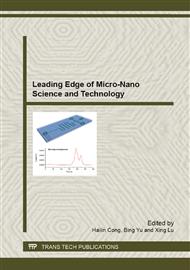[1]
Yuan Julong, Zhang Feihu, Dai Yifan, et al, Development Research of Science and Technologies in Ultra-precision Machining Field, Journal of Mechanical Engineering, 2010, 46(15): 161-176.
DOI: 10.3901/jme.2010.15.161
Google Scholar
[2]
H.T. Young, His-Tien Liao, Hong-Yi Huang, Surface integrity of silicon wafers in ultra precision machining, Int J Adv Manuf Technol, 2006, 29: 372-378.
DOI: 10.1007/s00170-005-2508-1
Google Scholar
[3]
F.J. Chen, S.H. Yin, H. Huang, et al, Profile error compensation in ultra-precision grinding of aspheric surfaces with on-machine measurement, Int J Machine Tool & Manufacture, 2010, 50: 480-486.
DOI: 10.1016/j.ijmachtools.2010.01.001
Google Scholar
[4]
C.F. Cheung, L.B. Kong, L.T. Ho, S. To, Modelling and simulation of structure surface generation using computer controlled ultra-precision polishing, Precision Engineering, 2011, 35: 574-590.
DOI: 10.1016/j.precisioneng.2011.04.001
Google Scholar
[5]
M. Tricard, W. I. Kordonski, A. B. Shorey, C. Evans, Magnetorheological Jet Finishing of Conformal, Freefrom and Steep Concave Optics, CIRP Annals-Manufacturing Technology. 2006, 55(1): 309-312.
DOI: 10.1016/s0007-8506(07)60423-5
Google Scholar
[6]
Guo Bing, Zhao Qingliang, Jachson Mark J, Zhao Lingling, Investigation of Precision Grinding Process on Superhard Molds with Microstructured Surface, Journal of Mechanical Engineering, 2011, 47(23): 174-179.
DOI: 10.3901/jme.2011.23.174
Google Scholar
[7]
Ikawa N, Shimada S, Donaldson R R, et al. Chip morphology minimum thickness of cut in micro-machining, J. Japan Soc. Prec. Engg. , 1993, 59: 673-678.
Google Scholar
[8]
Brown N J. Lapping: Polishing and shear mode grinding, J. Japan Soc. Prec. Engg. , 1990, 56(5): 800-805.
Google Scholar
[9]
M R Behzadi, B Arezoo, Static and dynamic models for predicting the effects of supports on machining flatness and roughness, Proceedings of the Institution of Mechanical Engineers, Part B: Journal of Engineering Manufacture, 2002, 216: 735-742.
DOI: 10.1243/0954405021520427
Google Scholar
[10]
Akinjide Olufemi Oluwajobi, Stanley Chimezie Obi, Xun Chen, Ultraprecision Machining of Inconel 718 with Nanometric Finish, Journal of Materials Science and Engineering, 2011, 5: 406-410.
Google Scholar
[11]
Jing Xiu-bing, Lin Bin, ZHANG Da-wei. Numerical Simulation of the Effect of Cutting Condition on Ultra-precision Cutting Process, Journal of Tinjin University, 2011, 44(12): 1101-1105.
Google Scholar
[12]
Madhusudhanan Srinivasraghavan, Zhongde Shi, et al, Numerical simulation of force distributions in the grinding contact zone, Int. J. Abrasive Technology, 2010, 3(1): 63-76.
Google Scholar
[13]
T.A. Nguyen, D.L. Butler, Simulation of precision grinding process, part 1: generation of the grinding wheel surface, Int J Machine Tools & Manufacture, 2005, 45: 1321-1328.
DOI: 10.1016/j.ijmachtools.2005.01.005
Google Scholar
[14]
T.A. Nguyen, D.L. Butler, Simulation of precision grinding process, part 1: interaction of the abrasive grain with the workpeice, Int J Machine Tools & Manufacture, 2005, 45: 1329-1336.
DOI: 10.1016/j.ijmachtools.2005.01.006
Google Scholar
[15]
Zhao Chunsheng, Ultrasonic Motors Technologies and Applications. Beijing: Science Press, (2011).
Google Scholar
[16]
Yao Zhiyuan, Wang Fengquan, Zhao Chunsheng, A Method of Online Damage Identification for Structure Based on Ambient Vibration, Applied Mathematics and Mechanics. 2005, 26(2): 269-276.
Google Scholar
[17]
Xu Hai, Zhao Chunsheng, Contact Process and Friction Analysis of Linear Ultrasonic Motor, Journal of Nanjing University of Aeronautics & Astronautics, 2005, 37(2): 144-149.
Google Scholar
[18]
Jiamei Jin, Chunsheng, Deformation & Rotation of Standing wave in the Annular Stators of Ultrasonic Motors, Proc. Symp, Ultrasonic Electron, 2005, 26: 269-270.
Google Scholar
[19]
Zhao Xiangdong, Liu Changqing, Sun Heming, Zhao Chunsheng, Output Characteristics of the Frictional Interface of Travelling Wave Type Ultrasonic Motors, Small & special Machines, 2000, 3: 21-23.
Google Scholar
[20]
Zhao Xiangdong, Chen Bo, Zhao Chunsheng, Nonlinearly Frictional Interface Model of Rotated Traveling Wave Type Ultrasoinc Motor, Journal of Nanjing University of Aeronautics & Astronautics, 2003, 35(6): 629-633.
Google Scholar


